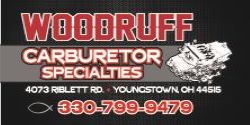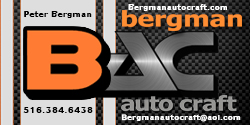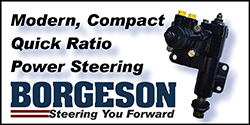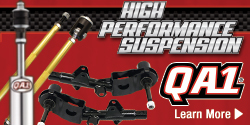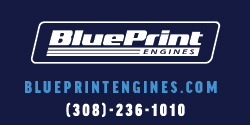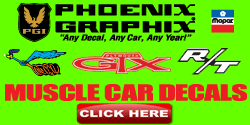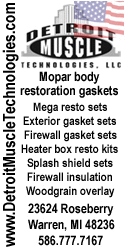The body shop down the street quoted me $500 to change the roof panel on my Challenger, including finishing the seams. They'd complained to my boss that "we don't get to do any fun stuff, just insurance work." So, I asked them if they wanted to do the roof for me. This isn't some half-assed fly-by-night operation, either--it's the highest-tech shop in the area. No compressed air, for example... they have a nitrogen generator that keeps up with two booths and all the air tools. The owner has two shops in other towns and a soft spot for classic Mopars. His toy is a cross-rammed 528" Hemi Dart (not an original Hurst conversion car).
You are using an out of date browser. It may not display this or other websites correctly.
You should upgrade or use an alternative browser.
You should upgrade or use an alternative browser.
Body shop
- Thread starter Monkeyed
- Start date
72Dodge
Well-Known Member
I will do my own bodywork on my cars because I enjoy working on my cars and enjoy doing some bodywork. But I wouldn't do someone else's car for a million dollars. Partially because it's really HARD work, but also because others don't understand that and would p*** and moan if something wasn't 100% perfect. I can live with not-quite-perfect knowing I built and finished my car myself.
Jack Meoff
Mopar Maniac
I will do my own bodywork on my cars because I enjoy working on my cars and enjoy doing some bodywork. But I wouldn't do someone else's car for a million dollars. Partially because it's really HARD work, but also because others don't understand that and would p*** and moan if something wasn't 100% perfect. I can live with not-quite-perfect knowing I built and finished my car myself.
I'm the same way.....
I'm actually pretty good at it.....in the non professional category
But for the very reasons you stated I don't do other peoples.
I have made exceptions though....
My brother in law's GMC work van was screaming "please pull me over"
So I did that for him....
I had no idea that rockers were an option on GM vans.
I'm probably going to get sucked into doing my buddy's 87 Ram too before it returns to the soil......
I'm pretty decent at bodywork as well, but I'm not equipped to tackle a roof skin and since the car is going to be black, I want it perfect. That's kind of ironic, since the roof seams on my original, never-repainted '73 Challenger were a freakin' travesty. I guess that's what happens over 80,000 miles of merciless pounding with a "really good" 340, a stick, and 4.10 gears. :icon_biggrin:
Jack Meoff
Mopar Maniac
I'm pretty decent at bodywork as well, but I'm not equipped to tackle a roof skin and since the car is going to be black, I want it perfect. That's kind of ironic, since the roof seams on my original, never-repainted '73 Challenger were a freakin' travesty. I guess that's what happens over 80,000 miles of merciless pounding with a "really good" 340, a stick, and 4.10 gears. :icon_biggrin:
Brings out the evil in you doesn't it?....lol.
Roof skins?
Yep.....my buddy's Ram is going to need one
I'll be calling in the professionals for that.
Hey, I only had it for 10% of those miles. But I was 17, so, y'know... I'm pretty sure the original owner beat the snot out of it too, though, considering he traded in a '67 Impala SS on it. Leads me to believe he was a bit of a horsepower junkie too.
Jack Meoff
Mopar Maniac
Hey, I only had it for 10% of those miles. But I was 17, so, y'know... I'm pretty sure the original owner beat the snot out of it too, though, considering he traded in a '67 Impala SS on it. Leads me to believe he was a bit of a horsepower junkie too.
It's like having a big 4bbl.....
"Just keep off the secondaries and the gas mileage ain't so bad"
Like that's gonna happen..... :icon_cheers:
ramenth
Well-Known Member
I will do my own bodywork on my cars because I enjoy working on my cars and enjoy doing some bodywork. But I wouldn't do someone else's car for a million dollars. Partially because it's really HARD work, but also because others don't understand that and would p*** and moan if something wasn't 100% perfect. I can live with not-quite-perfect knowing I built and finished my car myself.
With practice makes perfect. I was in no way in hell prepared to work flat-rate coming out of school, but three years later I was hauling ass. Within ten years I was pulling frames.Used to love some of those flat rate checks coming in: 100 hours of work completed in a 40 work week, stack and wrack those box side and quarter panel replacements! Eight hour box side sent to the paint shop in less than three hours, twenty hour quarter panels sent to the paint shop in six hours.
But, you're right. After a career of it I got burned out spending 40 hours a week on the frame wrack week after week, pulling banana-ed and swayed Rangers back into shape. The damned things bent easy, but came back hard. Firewall hits are never easy, either. Thanks to all of that I have repetitive motion in my left elbow, two bad knees, and now a bad hip of 25 years of accumulative automotive work. Tough job and it never pays enough. The elbow surgery alone is more than I earned in a year doing body work.
I'd go back to restoring cars in a heartbeat, though. As a matter of fact, I plan on it.
Jack Meoff
Mopar Maniac
With practice makes perfect. I was in no way in hell prepared to work flat-rate coming out of school, but three years later I was hauling ass. Within ten years I was pulling frames.Used to love some of those flat rate checks coming in: 100 hours of work completed in a 40 work week, stack and wrack those box side and quarter panel replacements! Eight hour box side sent to the paint shop in less than three hours, twenty hour quarter panels sent to the paint shop in six hours.
But, you're right. After a career of it I got burned out spending 40 hours a week on the frame wrack week after week, pulling banana-ed and swayed Rangers back into shape. The damned things bent easy, but came back hard. Firewall hits are never easy, either. Thanks to all of that I have repetitive motion in my left elbow, two bad knees, and now a bad hip of 25 years of accumulative automotive work. Tough job and it never pays enough. The elbow surgery alone is more than I earned in a year doing body work.
I'd go back to restoring cars in a heartbeat, though. As a matter of fact, I plan on it.
Most people have no clue how involved and labor intensive fixing a smacked up car is and then they b!tch about the price.
When you do get back into restoring you might be getting a call from me.
I like things done right and I know it would be if it went to you.
My imp
Well-Known Member
That's how I got started. I got sick of seeing people (including my Dad) pay good money for bad work. READ, READ, READ! After that, read some more. Everything from metal work to final cut & buff is one huge system. Anything skimped on will act like dominos. I'm sure you've seen it a million times, that prep is 90% of the job. Practice pulling, welding, forming, paint, etc. on the old metal you're cutting out. Or, you can use scrap you have lying around to practice on. Big ticket items such as plasma cutters, mig/tig/stick/spot welders, compressors, even body tools can be rented. Through the years, if you acquire these tools yourself, you can spread the cost over a few paint/body jobs. You'll easily have the cost of a great paint job tied up in tools, but if you get enough practice in & develop the necessary skills, every paint job you'll turn out will be great. You'll have no ones excuses to listen to, no shabby work that you're going to have to fight to get done right, plus, even the best body shops get slow & employment can get nomadic. Make sure the same crew is there from prep to delivery. I've heard many tales from people telling me about their favorite body shops painter left, now the new guys paint doesn't match, sh*tty body work, poor prep, all the goodies! As has been stated; if you put worn trim, seals, moldings, etc.. on a fresh paint job, they stick out like a sore thumb. Even though you recommended to the customer to replace or re-furnish them, if it isn't in writing, they'll swear you never said anything about it. Then you need to try to R/R an old molding on fresh paint, when you could've just installed new in the first place. If you get good enough to do it as a side gig, or business, you'll run into this more often than you think! The why are they so cheap story really rings true! Have your customer price out the materials himself, just so they see how much things cost. Sealers, primers, base coat, flake, candy color, pearl coat, & clear coat for some jobs. Don't forget thinners, reducers, catalysts, filters, shop materials, degreasers & silicone removers, etc.. It all adds up. Are you going to bake that finish? You might as well put a fan blade on your electric meter, for when you fire up your infrared baking units! None of its free, & I'm not a registered charity. If it costs me, it costs you! No one works free, the better you are, the more you charge. Why should you charge $5000 for a $10,000 paint job? Just because you're dont have the overhead of commercial shop, doesn't mean you shouldn't be compensated by the quality of your work vs. the size of your shop's sign & sq. footage. Enough soap boxing for tonight. Good luck!
I'm hesitant to do much of it myself. He said most of the trim is going to be almost irreplaceable if it got damaged and not to even attempt to remove any of it. I've not done much welding, if it wasn't for the holes, I'd try some more rust convertor, primer, and spot paint it. cutting out pieces, and welding new metal in, I'm sure with the right equipment and guidance I could manage some of it. some of the stuff around the bottoms of the doors, and around the mirrors, wipers, door handles, etc.. look a little out of my league.
Mr.Lopar
Well-Known Member
they probably said that so you wont remove it and they can make more money off ya for removing it
im sure you could remove most if not all yourself, and if you did fubar a piece or two up, im sure someone on here could help find another piece for ya.
im sure you posted it on here somewhere, but what car are you working on again?
im sure you could remove most if not all yourself, and if you did fubar a piece or two up, im sure someone on here could help find another piece for ya.
im sure you posted it on here somewhere, but what car are you working on again?
My imp
Well-Known Member
Just take your time, ask questions, use trim removal tools instead of prying something off. When the clips release, the strips generally pop off. If they don't, there's probably a missed clip somewhere. Don't pry at that point, you'll probably bend it. Does your local adult education offer auto body classes? Usually for a very nominal fee, you gain knowledge & access to professional auto body shop equipment (usually a pro paint booth also!). There's no limit to the amount of times you can take the class, so keep taking it until your car is done. Generally though, the car has to run. You need to drive the car in & out for each class, which can be a PITA. Contamination from daily driving, can't deeply disassemble a car due to nightly time constraints. It wouldn't be bad to have a local body shop "rent" nightly space by teaching the auto body trade. It's a win/win situation! You may find a new line of work, they may find a new employee? Some people love auto body/paint. If that's you, as they say,"get a job you love, & you'll never work a day in your life!". Hell, even my wife LOVES the smell of body filler! She's says it reminds her of her father doing bodywork on the family '64 1/2 Mustang in the driveway, when she was a kid. Five kids in the family learned how to drive in that 'stang. Anyone care to guess who trashed the clutch, thereby having the decision made to get rid of the car? 5 guesses, & the first 4 don't count. A little clue; her name starts with Janet!
ramenth
Well-Known Member
Most people have no clue how involved and labor intensive fixing a smacked up car is and then they b!tch about the price.
When you do get back into restoring you might be getting a call from me.
I like things done right and I know it would be if it went to you.
You're about 4 hours from me. I got some things in the works that may be setting up the future. Prayers are always welcome.
That's one of the reasons I'm sitting here thinking over the $5000 price for rust work. If your cutting and fabbing in, depending on the amount of rust and the amount of sheetmetal used, that's pretty much inline from a quality shop since you can easily have a hundred hours in a job like that.
Last edited:
ramenth
Well-Known Member
My advice for the novice is don't tape anything you don't have to. Taillights, trims, badges, take 'em off. Like I've said, I even remove the glass. Easy enough to tape the interior of the pinch weld to keep the paint from going in if you're leaving the interior intact.
iCar says remove it, don't tape it. The biggest thing I see from first time painters is they want to tape everything, thinking it will make for an easier job. It doesn't, especially in the long run as hard tape lines peel. You'll be doing it over again in a few years.
When it comes to automotive work, I'm lazy. I go for quality parts and quality material simply because I don't want to have to do it again. And again and again. Do it right the first time saves a lot of time later. Take your time.
There's things that come with feel. I have an airboard sitting in my toolbox. I hardly ever use it. I prefer to hand block everything. I can feel it "come in" better. There's some guys out there who can feel it through the airboard. It's a practiced feel.
Painting is always hit and miss, especially for someone new at it. A good painter makes every mistake in the book when he first gets started and I think I wrote some new ones into the book. It's a matter of learning from those mistakes to eliminate them the next time. That being said, painting, to me, has always been more of a talent and less than a learned skill. I've worked with guys who have been at it for years who just shouldn't be allowed to touch a gun. I've seen guys who are new at it who just have a natural ability to understand what's going on.
Be prepared to work hard at it. It's not easy. It's frustrating. Things aren't going to right. Give it a try. Don't be afraid of it. Failure is always an option. If you're afraid of failing, then you're afraid of succeeding and the end results just may surprise you. It also gives you an idea as to why the shop down the road is charging what they do.
iCar says remove it, don't tape it. The biggest thing I see from first time painters is they want to tape everything, thinking it will make for an easier job. It doesn't, especially in the long run as hard tape lines peel. You'll be doing it over again in a few years.
When it comes to automotive work, I'm lazy. I go for quality parts and quality material simply because I don't want to have to do it again. And again and again. Do it right the first time saves a lot of time later. Take your time.
There's things that come with feel. I have an airboard sitting in my toolbox. I hardly ever use it. I prefer to hand block everything. I can feel it "come in" better. There's some guys out there who can feel it through the airboard. It's a practiced feel.
Painting is always hit and miss, especially for someone new at it. A good painter makes every mistake in the book when he first gets started and I think I wrote some new ones into the book. It's a matter of learning from those mistakes to eliminate them the next time. That being said, painting, to me, has always been more of a talent and less than a learned skill. I've worked with guys who have been at it for years who just shouldn't be allowed to touch a gun. I've seen guys who are new at it who just have a natural ability to understand what's going on.
Be prepared to work hard at it. It's not easy. It's frustrating. Things aren't going to right. Give it a try. Don't be afraid of it. Failure is always an option. If you're afraid of failing, then you're afraid of succeeding and the end results just may surprise you. It also gives you an idea as to why the shop down the road is charging what they do.
I'm not a pro, nor have I done an overall paint job yet, but I have a couple of suggestions.
What I did with my LeBaron was to start with the engine bay and the outside of the inner fenders. It didn't matter in that area because it would all have been hidden by the fender and undercoating. I stripped them down to bare metal using both chemical stripper and sandpaper (depending on location) and made some necessary metal repairs. Not surprisingly, the metal repairs were initially pretty ugly. I was getting the hang of welding sheetmetal, but my improvement was rather impressive between start and finish. Though I'm not much of a welder, I'm a hell of a grinder. :icon_biggrin:
Using the same "won't be seen anyhow" logic, I figured it was also a good place to get the hang of my new spray guns especially since I was shooting Chrysler PEL/WEL Inferno Red, which is both a metallic and a pearl. Making sure you start with an immaculately clean gun is of utmost importance. If you're not sure, rip it apart and clean it thoroughly. I adjusted the guns to spray patterns that I liked as far as shape and coverage and went from there. Yes, I have very good guns but being a total beginner I got results that would make any painter proud: no runs, no sags or "dry" areas, and excellent dispersion of both the pearl and metallic. The clear was a cakewalk, and the result was gorgeous as-sprayed. I felt ready to take on the world after that; the outside of an inner fender is a fairly tricky area. I had no qualms about my ability to do the overall when the time came, which it never did. I shot Akzo Nobel's U-Tech Polybase & covered with the discontinued P80 clear, both of which are miles ahead of PPG's Omni and DuPont's Nason lines in terms of quality and ease of spraying (yes, I did some non-automotive work with both later). These are all budget lines of paint that cost far less than Sikkens, PPG, or DuPont-branded products and for that reason are often used by home enthusiasts/DIY types.
This area was where I made an important discovery, about which I'm sure ramenth will agree: Avoid "miracle paints" such as POR-15, Chassis Saver, or anything else that makes similar claims no matter who makes it. Those paints do not like smooth or lightly-sanded sheetmetal and will peel off in sheets after less time than you would expect. Those paints are designed to adhere to rust-pitted or heavily-etched metal, such as 80-grit sand scratches. If you want to go over a whole area like that, well, that's your call but keep in mind that missing an area half the size of a dime will result in the paint coming off in fairly short order. It happened to me and it happened to a friend of mine who is currently looking at redoing his entire car, including the rust that formed underneath the POR-15. I did not use POR-15, but a similar product. I was lucky because I'd not laid down color prior to the paint releasing from the metal. He brushed his, I used a cheap touch-up gun. Use a good automotive primer designed for direct-to-metal application where required; some like epoxies and others don't. Ask ramenth, or get familiar with a local body shop that's either owned/managed by someone who owns a classic himself or specializes in older cars and hot rods. Personally, I used U-Tech E350 and had very good results (can you tell I was an Akzo dealer at the time?).
For the record, the inexpensive gun I used for the "miracle paint" subsequently had to be thrown out. If you miss even a miscroscopic speck of that stuff during cleaning, it will weld the gun solid. I took great care cleaning that gun and in the end it was still stuck. Had that been one of my primary guns, it would've been a $250-$600 mistake.
If any of this is erroneous in the eyes of the professionals, please point it out and explain. I'm all about learning this too. I'm only commenting on the little bit I've done and any corrections are very welcome.
What I did with my LeBaron was to start with the engine bay and the outside of the inner fenders. It didn't matter in that area because it would all have been hidden by the fender and undercoating. I stripped them down to bare metal using both chemical stripper and sandpaper (depending on location) and made some necessary metal repairs. Not surprisingly, the metal repairs were initially pretty ugly. I was getting the hang of welding sheetmetal, but my improvement was rather impressive between start and finish. Though I'm not much of a welder, I'm a hell of a grinder. :icon_biggrin:
Using the same "won't be seen anyhow" logic, I figured it was also a good place to get the hang of my new spray guns especially since I was shooting Chrysler PEL/WEL Inferno Red, which is both a metallic and a pearl. Making sure you start with an immaculately clean gun is of utmost importance. If you're not sure, rip it apart and clean it thoroughly. I adjusted the guns to spray patterns that I liked as far as shape and coverage and went from there. Yes, I have very good guns but being a total beginner I got results that would make any painter proud: no runs, no sags or "dry" areas, and excellent dispersion of both the pearl and metallic. The clear was a cakewalk, and the result was gorgeous as-sprayed. I felt ready to take on the world after that; the outside of an inner fender is a fairly tricky area. I had no qualms about my ability to do the overall when the time came, which it never did. I shot Akzo Nobel's U-Tech Polybase & covered with the discontinued P80 clear, both of which are miles ahead of PPG's Omni and DuPont's Nason lines in terms of quality and ease of spraying (yes, I did some non-automotive work with both later). These are all budget lines of paint that cost far less than Sikkens, PPG, or DuPont-branded products and for that reason are often used by home enthusiasts/DIY types.
This area was where I made an important discovery, about which I'm sure ramenth will agree: Avoid "miracle paints" such as POR-15, Chassis Saver, or anything else that makes similar claims no matter who makes it. Those paints do not like smooth or lightly-sanded sheetmetal and will peel off in sheets after less time than you would expect. Those paints are designed to adhere to rust-pitted or heavily-etched metal, such as 80-grit sand scratches. If you want to go over a whole area like that, well, that's your call but keep in mind that missing an area half the size of a dime will result in the paint coming off in fairly short order. It happened to me and it happened to a friend of mine who is currently looking at redoing his entire car, including the rust that formed underneath the POR-15. I did not use POR-15, but a similar product. I was lucky because I'd not laid down color prior to the paint releasing from the metal. He brushed his, I used a cheap touch-up gun. Use a good automotive primer designed for direct-to-metal application where required; some like epoxies and others don't. Ask ramenth, or get familiar with a local body shop that's either owned/managed by someone who owns a classic himself or specializes in older cars and hot rods. Personally, I used U-Tech E350 and had very good results (can you tell I was an Akzo dealer at the time?).
For the record, the inexpensive gun I used for the "miracle paint" subsequently had to be thrown out. If you miss even a miscroscopic speck of that stuff during cleaning, it will weld the gun solid. I took great care cleaning that gun and in the end it was still stuck. Had that been one of my primary guns, it would've been a $250-$600 mistake.
If any of this is erroneous in the eyes of the professionals, please point it out and explain. I'm all about learning this too. I'm only commenting on the little bit I've done and any corrections are very welcome.
ramenth
Well-Known Member
I'm not a pro, nor have I done an overall paint job yet, but I have a couple of suggestions.
What I did with my LeBaron was to start with the engine bay and the outside of the inner fenders. It didn't matter in that area because it would all have been hidden by the fender and undercoating. I stripped them down to bare metal using both chemical stripper and sandpaper (depending on location) and made some necessary metal repairs. Not surprisingly, the metal repairs were initially pretty ugly. I was getting the hang of welding sheetmetal, but my improvement was rather impressive between start and finish. Though I'm not much of a welder, I'm a hell of a grinder. :icon_biggrin:
The idea of spraying jams, engine bays, etc, work if you're piecing it in and want a rolling restoration. No way is the wrong way when it comes to how you do it. Personally, though, I'm a big fan of just ripping the car apart and carrying it from start to finish. As a result I usually paint the restoration the same way the factory did it. Since we're concentrating on Mopars here, that means hood on, fenders on, decklid on, doors off. Each panel sprayed top and bottom, inside and out, all at once, including the engine bay. Of course, this means doing the "great body drop" for the engine/trans/front K installed as a sub-assembly, but it makes for a cleaner job in the long run.
I want to re-iterate, though, what's right for me, may not be right for you. I restored as a pro and as such I had the equipment and the garage to be able to do all this.
As far as welding, just like everything else, it takes practice. I'm great with the MiG from all my years of doing this. Not so great with a stick, though I'm getting better. A TiG? Still learning that, too, so I'm by no means a welder. I am, however a good panel welder.
NoCar said:Using the same "won't be seen anyhow" logic, I figured it was also a good place to get the hang of my new spray guns especially since I was shooting Chrysler PEL/WEL Inferno Red, which is both a metallic and a pearl. Making sure you start with an immaculately clean gun is of utmost importance. If you're not sure, rip it apart and clean it thoroughly. I adjusted the guns to spray patterns that I liked as far as shape and coverage and went from there. Yes, I have very good guns but being a total beginner I got results that would make any painter proud: no runs, no sags or "dry" areas, and excellent dispersion of both the pearl and metallic. The clear was a cakewalk, and the result was gorgeous as-sprayed. I felt ready to take on the world after that; the outside of an inner fender is a fairly tricky area. I had no qualms about my ability to do the overall when the time came, which it never did. I shot Akzo Nobel's U-Tech Polybase & covered with the discontinued P80 clear, both of which are miles ahead of PPG's Omni and DuPont's Nason lines in terms of quality and ease of spraying (yes, I did some non-automotive work with both later). These are all budget lines of paint that cost far less than Sikkens, PPG, or DuPont-branded products and for that reason are often used by home enthusiasts/DIY types.
Paint type doesn't bother me. We all have a preference. My preference is PPG's Concept system. DCU 2002 isn't for the feint of heart and should be tackled with a lot of practice and experience. When it first hit the shelves I was the only guys in the area to get it to lay in. The local paint jobber, all of them PPG certified, called me looking for advice on what to tell the guys out in the shops on how to get the results I was getting. My "secret" was knowing my paint conditions: temp, humidity, air flow and getting the paint RTS from there. The proper hardener, the proper reducer. Since I was laying down show car paint jobs, I wanted the maximum flow time I could get and would make my decisions on hardeners and reducers, and how much to use of both from there.
Find a paint product and buy extra. Use the extra to practice with, even if it's on an old hood you have laying around. Prep it like you would if you were putting it on the car. And practice some more.
I've seen a damned nice looking Duster belonging to a guy in GA who sprayed the car with Rustoleum by the gallon.
As far as guns go, yes, it is important to keep the gun clean. One of the reasons I've so many guns at my disposal. Each for different purposes, each with a different set up (I'll mix and match needles and tips to get what I want). Each regulator is set where I want it. I'll flow thinner through each gun as a quick clean up after each stage of the job and then, once the job is done, I'll take it completely apart for a more thorough clean up. Once I start the sealer on a job, I'm not stopping.
NoCar said:This area was where I made an important discovery, about which I'm sure ramenth will agree: Avoid "miracle paints" such as POR-15, Chassis Saver, or anything else that makes similar claims no matter who makes it. Those paints do not like smooth or lightly-sanded sheetmetal and will peel off in sheets after less time than you would expect. Those paints are designed to adhere to rust-pitted or heavily-etched metal, such as 80-grit sand scratches. If you want to go over a whole area like that, well, that's your call but keep in mind that missing an area half the size of a dime will result in the paint coming off in fairly short order. It happened to me and it happened to a friend of mine who is currently looking at redoing his entire car, including the rust that formed underneath the POR-15. I did not use POR-15, but a similar product. I was lucky because I'd not laid down color prior to the paint releasing from the metal. He brushed his, I used a cheap touch-up gun. Use a good automotive primer designed for direct-to-metal application where required; some like epoxies and others don't. Ask ramenth, or get familiar with a local body shop that's either owned/managed by someone who owns a classic himself or specializes in older cars and hot rods. Personally, I used U-Tech E350 and had very good results (can you tell I was an Akzo dealer at the time?).
I avoid "miracle" paints like the plague. Nothing, but nothing beats clean sheetmetal. If you're putting something like POR-15 on a rusty panel, ask yourself, why am I painting over rust?
That being said, NoCar is right. These paints are designed to go over rusty or very rough metals. They will not stick to clean metal unless it's been heavily etched. Even then, these paints resist sanding for any kind of top coat.
I'm a snob in the way I do things and the material I use. What I prefer is not cheap and gives what I have seen to be the best results. It's not for everyone, especially if you're working on a budget and/or doing it for the first time. It comes with years of honing my skills. The way I prefer to do things isn't necessarily what will work for you, your time constraints, your budget, and your space. I say this all as a caveat. I made my living doing this.
Well, my reasoning for the engine bay and outside of the inner fenders was that those areas would be covered by the hood and fenders when I went to do the main paint job. The car was exploded almost all the way down in my garage, except I hadn't yet removed the doors or the trunklid due to very limited space.
As far as the paint used by either one of us, the reason I used what I did was because for the average Joe doing a DIY in his home garage (as I was), your top-shelf paints such as Sikkens, Spies-Hecker, and top-level PPG or DuPont coatings are brutally expensive. Jobber cost on a gallon of WEL red was over $700 in both Sikkens and PPG ChromaBase, and then there were the incidental chemicals, primer, and clear to consider on top of all that. I simply did not have the finances to drop $3,000 in materials. I still don't, so when the time comes I'll most likely be shooting U-Tech again, at least for the base. The P80 clear is no longer available, so I'll have to check around on a replacement.
As far as the paint used by either one of us, the reason I used what I did was because for the average Joe doing a DIY in his home garage (as I was), your top-shelf paints such as Sikkens, Spies-Hecker, and top-level PPG or DuPont coatings are brutally expensive. Jobber cost on a gallon of WEL red was over $700 in both Sikkens and PPG ChromaBase, and then there were the incidental chemicals, primer, and clear to consider on top of all that. I simply did not have the finances to drop $3,000 in materials. I still don't, so when the time comes I'll most likely be shooting U-Tech again, at least for the base. The P80 clear is no longer available, so I'll have to check around on a replacement.
ramenth
Well-Known Member
Well, my reasoning for the engine bay and outside of the inner fenders was that those areas would be covered by the hood and fenders when I went to do the main paint job. The car was exploded almost all the way down in my garage, except I hadn't yet removed the doors or the trunklid due to very limited space.
Like I said: I had the space and the equipment. When you have multiple bays at your disposal a car in pieces can fill as many bays as needed. The shop I was in was 50x100. When you don't have that space, you do what you gotta do. There's no right way or wrong, I just have my preferred way and thought I would explain it.
As far as the paint used by either one of us, the reason I used what I did was because for the average Joe doing a DIY in his home garage (as I was), your top-shelf paints such as Sikkens, Spies-Hecker, and top-level PPG or DuPont coatings are brutally expensive. Jobber cost on a gallon of WEL red was over $700 in both Sikkens and PPG ChromaBase, and then there were the incidental chemicals, primer, and clear to consider on top of all that. I simply did not have the finances to drop $3,000 in materials. I still don't, so when the time comes I'll most likely be shooting U-Tech again, at least for the base. The P80 clear is no longer available, so I'll have to check around on a replacement.
Paint is always a budget buster. My preferred primer, NCP, is $300 a gallon. I go through 2 gallons in a typical restoration. And that's just the primer. Work within your budget.
I will add this for those reading. Find a good paint jobber in your town or one local to you. Internet and mail order paints my look good for your budget, but consider after the support sales. The top of the line manufacturers usually have a "low-line" paint to fit in your budget that can be bought from and supported by your local jobber. All the guys at my jobber are available to answer question on any given paint they sale... they've helped me on the other end of the phone when something wasn't going right and we were able to brainstorm solutions. This can, and will help, a novice who's first getting started all the way up to any of the pro's out there. Tech support over the phone from someone selling parts for a living (I'm looking at you, Summit) can be hit or miss with tech support and overall support for someone spraying paint for the first time.
Last edited:
My imp
Well-Known Member
I worked with a guy who used to put his rendition of Niagra Falls (American & Canadian!) in primer & clear coat. His metal skills were marginal at best. But boy could he sling some mud! He could probably build a car completely out of mud, park it next to the real thing, & I'd defy anyone to tell the difference! He's actually had a couple cars in major auto rags. One was a Nova in some Super Chevy, another was a GTO in Hot Rod, or one of those. He felt that you could sand runs out easier than scuffing & squirting over "dry" spots. He literally used 1/2 of a quart of primer on a guitar body. No neck, all interior surfaces masked off. Just a small solid body guitar. It took me 6 hrs to get the primer sanded down. So I know what you mean about someone who should never hold a spray gun in his hand! I use HVLP SATA guns for everything but primer. I use Nesco genuine/imitation SATA guns for primer. After I sanded that guitar body down, I re-primed it with 3oz.'s of primer! The most successful method of rust conversion is R/R. Por15 works well on rusted metal, as stated above. But you can literally hook an edge with a blade & peel it right off of clean, bare metal. I found that using their etch makes no difference whatsoever. The thing it adheres to best, is your skin if you don't take it off when wet! I can't work consistently with my screwed up back. Sometime's I bend over, or squat one time, & I'm done for the day, or week, or longer. If I ever get this thing straightened out....... I'd love to say I could get a halfway decent paint job on one of the Imp.'s before the Nat.'s, but I still don't have that kind of access to a garage full-time like that. Like Latka (Taxi) used to say, "If it one thing, it's always another!"My advice for the novice is don't tape anything you don't have to. Taillights, trims, badges, take 'em off. Like I've said, I even remove the glass. Easy enough to tape the interior of the pinch weld to keep the paint from going in if you're leaving the interior intact.
iCar says remove it, don't tape it. The biggest thing I see from first time painters is they want to tape everything, thinking it will make for an easier job. It doesn't, especially in the long run as hard tape lines peel. You'll be doing it over again in a few years.
When it comes to automotive work, I'm lazy. I go for quality parts and quality material simply because I don't want to have to do it again. And again and again. Do it right the first time saves a lot of time later. Take your time.
There's things that come with feel. I have an airboard sitting in my toolbox. I hardly ever use it. I prefer to hand block everything. I can feel it "come in" better. There's some guys out there who can feel it through the airboard. It's a practiced feel.
Painting is always hit and miss, especially for someone new at it. A good painter makes every mistake in the book when he first gets started and I think I wrote some new ones into the book. It's a matter of learning from those mistakes to eliminate them the next time. That being said, painting, to me, has always been more of a talent and less than a learned skill. I've worked with guys who have been at it for years who just shouldn't be allowed to touch a gun. I've seen guys who are new at it who just have a natural ability to understand what's going on.
Be prepared to work hard at it. It's not easy. It's frustrating. Things aren't going to right. Give it a try. Don't be afraid of it. Failure is always an option. If you're afraid of failing, then you're afraid of succeeding and the end results just may surprise you. It also gives you an idea as to why the shop down the road is charging what they do.

